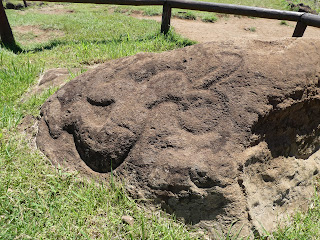We began our day at Ana Te Caves where some of the Rapa Nui tribes lived . This was followed by Ahu Akivi where 7 moai (statues) stand on an altar (ahu). Although there are many explanations of why they exsist our guide was insistant that they were there to pay homage to the most important member of the family (usually a man - suprise, suprise). This place had 7 families living there so there are 7 moai. These particular Moai are facing out to sea pointing in the direction of where they came from as they were the first settlers. All the other Moai face inland overlooking and protecting their people.
When the person died they took out all the internal organs, dried the body out, used the bones as implements eg Jaw bone for fishing, but kept the femur which was placed under the statue and their spirit would enter it. Large eyes were cut out of the stone and filled with white coral (this has since disappeared). For a long time there was civil war and the different tribes fought each other and destroyed a lot of the moai that is why a lot of them are lying down or in pieces. There was also a lot of cannibalism going on. Eventually peace prevailed and the culture changed. Europeans came to the island on Easter Sunday 1722 - hence the name
 |
| A bees nest in the caves |
We then moved on to a quarry where they mined a red rock for the pukao (headdress or top knot) , Mostly these are found lying on the ground as they fell off very easily.
At Vinapu we saw evidence of a wall that had a small brick in it which is there to absorb the energy created by eartquakes - this is very similar to the wall built by the Incas at Machu Picchu and suggests that the Incas have visited the Island and passed on their knowledge. Also at this site was a headless statue of a woman - most unusual, not much is known about it but early drawings by Europeans depict it with 2 heads and no-one knows what has happened to them (she could have been a siamese twin and considered a god)
Our next port of call was the Rano Kau volcano which has been extinct for the last 2ooo years. The crater is full of water and reeds and by the edge on the seaside is a village where people lived in homes built into the side of the volcano. They had a tradition where all the fit men competed to be 'birdman' which involved them climbing down the volcano to the sea and swimming across to a small island about 10000 meters way on a raft made out of the reeds (it was conical in shape and contained food and sometimes even live chickens). They waited on the island until the birds came and laid their eggs then secured one in their headbands and returned to the village to present the king with the egg. The first one there was the winner and his prize was a woman. All the eggs were nurtured and hatched which brought the village good luck
We also went on to see some paintings inside a cave on the coast at Ana Kai Tangata
 |
| Headresses |
 |
| The 'Inca' wall |
 |
| The headless woman |
 |
| The volcano |
 |
| The village built into the volcano |
 |
| The 'bird' island |
 |
| The cave |
 |
| Cave painting |













4 comments:
Wow & wow!! Not sure about the cannibalism bit...but needs must I suppose. How many maoi are there approximately?
There are hundreds visible, some in a state of collapse, others buried so that you only see their faces and others completely buried. Originally the Moai were only a few feet high but as time passed they got bigger and bigger, the average about 12 meters but the tallest found so far was 20 meters
Stunning. X
Stunning was me B. I'm trying to get my name to show! I am anonymous all the time. Has it worked.... Taylor X
Post a Comment